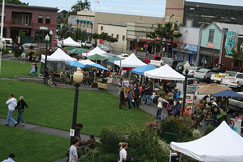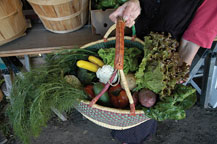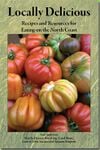Food produced in our core region is abundant. The rivers and sea provide fish and shellfish. Farmers and ranchers produce a wide variety of vegetables, fruit, meat, eggs, dairy products and wine. Extending the local area to about a 250-mile range adds rice, more varieties of cheese, olive oil, vinegars and even more wine.
There are three options for acquiring local food: buy it, grow it or find it through foraging, fishing or hunting. If you’re lucky, you have a friend with a farm or garden who likes to share. Many people do like to share, especially their zucchini!
Where to Buy Local Food
Food can be purchased directly from farmers and producers at farmers’ markets, farm stands or CSA farms. You can also buy it indirectly through retail groceries and restaurants.
Farmers’ Markets
The farmers’ markets operate from spring through fall. There are currently 13 markets in Del Norte, Humboldt and Trinity Counties. The Arcata Plaza market, run by the North Coast Growers Association, is the longest-running farmers’ market in California and has been in continuous operation since 1979.
| The U.S. Department of Agriculture estimates more than a million people visit a Farmers’ Market weekly. More than 20,000 farmers use farmers’ markets to sell to consumers. You can find complete list of farmers’ markets in Del Norte, Humboldt and Trinity Counties in Appendix B. |

Farm Stands, U-Picks and Buying Directly
Some farmers, ranchers, and producers have farm stands or stores or will allow you to pick your own produce. Others have on-line sales. Appendix C is a list of farms, ranches, dairies and fishers. The list indicates what each producer grows, raises or catches and how their products are sold directly. Appendix C also has a web site link to RedwoodAg, where you can do an interactive search for a particular food. Redwood.Ag is sponsored by the University of California Agricultural Extension Office.
Grocery Stores
Many local and regional grocery stores purchase produce, meat, dairy and packaged products for resale from our local producers. Appendix D has a list of grocery stores that sell locally-produced food. When you shop, let the store owner or manager know that you appreciate their support of the local agricultural community and ask if they can do more. Encourage them to label the source of the fresh products. Look at the labels on packaged products and buy as locally as possible.
Restaurants
Don’t want to cook but want good local food? Eat at some of the restaurants that use and feature local food. Humboldt Community Alliance with Family Farmers (Humboldt-CAFF) has started a program to encourage restaurants to create special local meals—look for the “Buy Fresh, Buy Local” sign at the participating restaurants.
If your favorite restaurant does not use local food, encourage them to do so. Use the restaurant list in Appendix E when choosing a restaurant and let them know that you appreciate their use of local food.

Locally-Packaged-Food Producers
Some locally-packaged-food producers sell directly to the public; most sell through retail groceries. Although many of these companies buy few (or no) ingredients from nearby primary producers, they are included in this book because buying locally-processed food in some respects lessens the carbon footprint, while at the same time encouraging and supporting a regional economy. Local producers are also more likely to incorporate local ingredients as they become available. Appendix F lists local packaged-food companies.
Community Supported Agriculture Farms (CSAs)
This region supports 13 Community Supported Agriculture Farms. Humboldt County’s Democracy Unlimited provides an excellent definition:
| This method of farming allows the farmer security in knowing that the crops are sold right from the start of the season. Members purchase shares in the output of the farm and receive a box or bag of fresh food each week during the season. Buying a share in a CSA is a way to lower the overall cost of the food for the consumer and get the freshest food available. It also helps to support and extend local food production. You can even go see your food growing - what fun! |
The CSAs are listed in Appendix G. Some CSAs have internships available for those who want to learn how to grow their own food.

